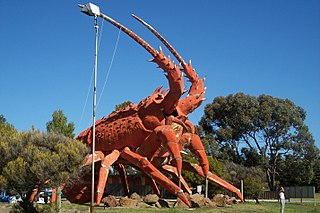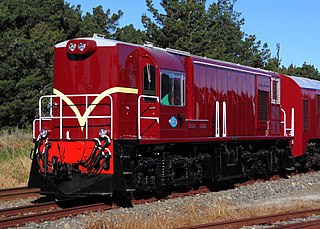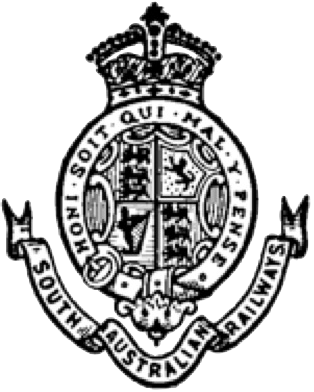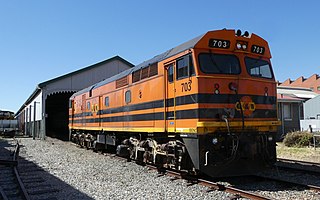| South Australian Railways V class | |||||||||||||||||||||||||||||||||
|---|---|---|---|---|---|---|---|---|---|---|---|---|---|---|---|---|---|---|---|---|---|---|---|---|---|---|---|---|---|---|---|---|---|
 Preserved V9 at Naracoorte | |||||||||||||||||||||||||||||||||
| |||||||||||||||||||||||||||||||||
| |||||||||||||||||||||||||||||||||
| |||||||||||||||||||||||||||||||||
| |||||||||||||||||||||||||||||||||
The South Australian Railways V class was a class of 0-4-4 steam locomotives operated by the South Australian Railways.
| South Australian Railways V class | |||||||||||||||||||||||||||||||||
|---|---|---|---|---|---|---|---|---|---|---|---|---|---|---|---|---|---|---|---|---|---|---|---|---|---|---|---|---|---|---|---|---|---|
 Preserved V9 at Naracoorte | |||||||||||||||||||||||||||||||||
| |||||||||||||||||||||||||||||||||
| |||||||||||||||||||||||||||||||||
| |||||||||||||||||||||||||||||||||
| |||||||||||||||||||||||||||||||||
The South Australian Railways V class was a class of 0-4-4 steam locomotives operated by the South Australian Railways.
In November 1876 the South Australian Railways took delivery of four 0-4-4 locomotives from Beyer, Peacock & Co, Manchester for use on the lightly laid Kingston-Naracoorte railway line. After final assembly was completed in South Australia, all entered service between January and May 1877. They were built to the same design as the Norwegian State Railways V1 class. [1]
They were not a success being too light and having insufficient water capacity for the 84 kilometre journey, requiring a water gin to be attached. In 1879, two W class locomotives were transferred with V9 becoming the shunter at Kingston wharf and the other three stored. [1]
In 1882, V12 was returned to service at Port Germein before moving to Port Pirie, while in the same year V10 was transferred to Port Wakefield, the latter was joined by V11 in 1885. In 1888, V9 moved to Port Augusta. From November 1891 until May 1893, V11 was loaned to BHP to operate on its lightly laid Broken Hill network. All four were rebuilt between 1891 and 1896. Between September and December 1893, a further four were delivered from James Martin & Co. [1]
They operated at various locations including Peterborough, Port Lincoln, Terowie and Wallaroo. Some were loaned interstate during the construction of the Yallourn Power Station. Most were withdrawn in the 1930s and 1940s with V9 plinthed at Pioneer Park, Naracoorte. [1]
|

Under the Whyte notation for the classification of steam locomotives, 0-4-0 represents one of the simplest possible types, that with two axles and four coupled wheels, all of which are driven. The wheels on the earliest four-coupled locomotives were connected by a single gear wheel, but from 1825 the wheels were usually connected with coupling rods to form a single driven set.

Beyer, Peacock and Company was an English railway locomotive manufacturer with a factory in Openshaw, Manchester. Founded by Charles Beyer, Richard Peacock and Henry Robertson, it traded from 1854 until 1966. The company exported locomotives, and machine tools to service them, throughout the world.

The first railway in colonial South Australia was a line from the port of Goolwa on the River Murray to an ocean harbour at Port Elliot, which first operated in December 1853, before its completion in May 1854.

Kingston SE formerly Kingston is a town in the Australian state of South Australia located in the state's south-east coastline on the shores of Lacepede Bay. It is located about 240 kilometres southeast of the state capital of Adelaide and 138 kilometres north-west of the centre of the city of Mount Gambier. At the 2016 census, Kingston SE had a population of 1,648.

The New Zealand DI class locomotive was a class of diesel-electric locomotive in New Zealand. They were built by English Electric at their plant in Rocklea, Queensland in Australia. The class is very similar to the Queensland Railways 1620 class locomotives. At the time of their introduction, the class was seen as an alternative to the DB class for use on lightly laid secondary and branch lines, more so in the South Island. The World Bank financed introduction of the Japanese built DJ class in 1968, which ensured that no further DI class locomotives were purchased by New Zealand Railways.

South Australian Railways (SAR) was the statutory corporation through which the Government of South Australia built and operated railways in South Australia from 1854 until March 1978, when its non-urban railways were incorporated into Australian National, and its Adelaide urban lines were transferred to the State Transport Authority.

The 80 class are a class of diesel locomotives built by Comeng for the Public Transport Commission between 1978 and 1983.

The South Australian Railways 620 class was a class of 4-6-2 steam locomotives operated by the South Australian Railways.

The South Australian Railways 520 class is a class of 4-8-4 steam locomotives operated by the former South Australian Railways.

The 70 class were a class of diesel-hydraulic locomotives built by Commonwealth Engineering, Granville for the New South Wales Department of Railways in 1960–61. They were ordered to replace steam locomotives at Port Kembla.

The H class was a class of two steam locomotives operated by the Western Australian Government Railways (WAGR) introduced in 1889.

The 500 class were a class of South Australian Railways diesel shunter locomotives built at Islington Railway Workshops between 1964 and 1969.

The South African Railways Class NG G16 2-6-2+2-6-2 is a narrow gauge steam locomotive class.

The 700 class is a class of six diesel-electric locomotives based on the Alco DL500G model, built by AE Goodwin, Auburn, New South Wales for the South Australian Railways. They are virtually identical to the New South Wales 442 class locomotive.

The South Australian Railways T class was a class of 4-8-0 steam locomotives operated by the South Australian Railways. Several were sold to the Tasmanian Government Railways; some others operated on the Commonwealth Railways.

The South Australian Railways W and Wx class was a class of 2-6-0 steam locomotives operated by the South Australian Railways. Some were used by the Commonwealth Railways in the Northern Territory and by contractors.
The Mount Gambier railway line was a railway line on the South Australian Railways network. Opened in stages from 1881, it was built to narrow gauge and joined Mount Gambier railway station, which was at that time the eastern terminus of a line to Beachport. It connected at Naracoorte to another isolated narrow gauge line joining Naracoorte to Kingston SE, and to the broad gauge Adelaide-Wolseley line at Wolseley, at around the same time that was extended to Serviceton to become the South Australian part of the interstate Melbourne–Adelaide railway. Since its closure in 1995 following the standardisation of the interstate main line, there have been varying calls for standardisation of the railway between Wolseley and Heywood.

The South Australian Railways A Class locomotives arrived for the South Australian Railways in September and October 1868 from Robert Stephenson and Company. A third and final locomotive was ordered and arrived in 1873, these locomotives were withdrawn between 1893 and 1924 from the SAR after many years of hard service.

Eighteen South Australian Railways K class (broad-gauge) locomotives were built by Beyer, Peacock and Company for the South Australian Railways (SAR) between 1878 and 1884. Despite having a fundamental design flaw that affected their original role as light-line passenger locomotives, they eventually performed shunting duties exclusively. They operated for six decades.

Four South Australian Railways L class broad-gauge locomotives with a 4-4-0 wheel arrangement were built by Beyer, Peacock and Company in 1879 and entered service in March–April 1880. They were condemned in 1928 and 1931, and were subsequently scrapped.
![]() Media related to South Australian Railways V class at Wikimedia Commons
Media related to South Australian Railways V class at Wikimedia Commons